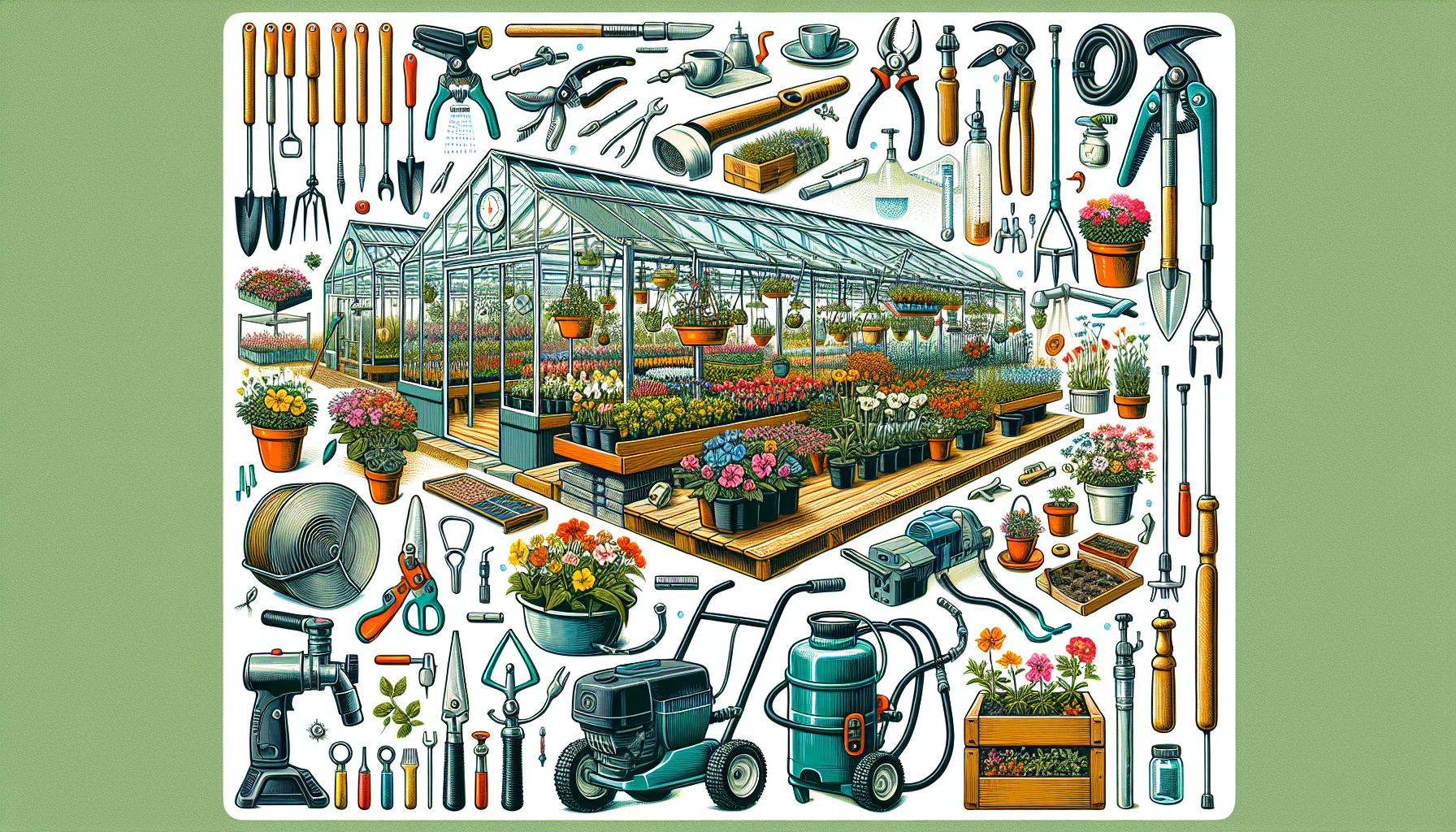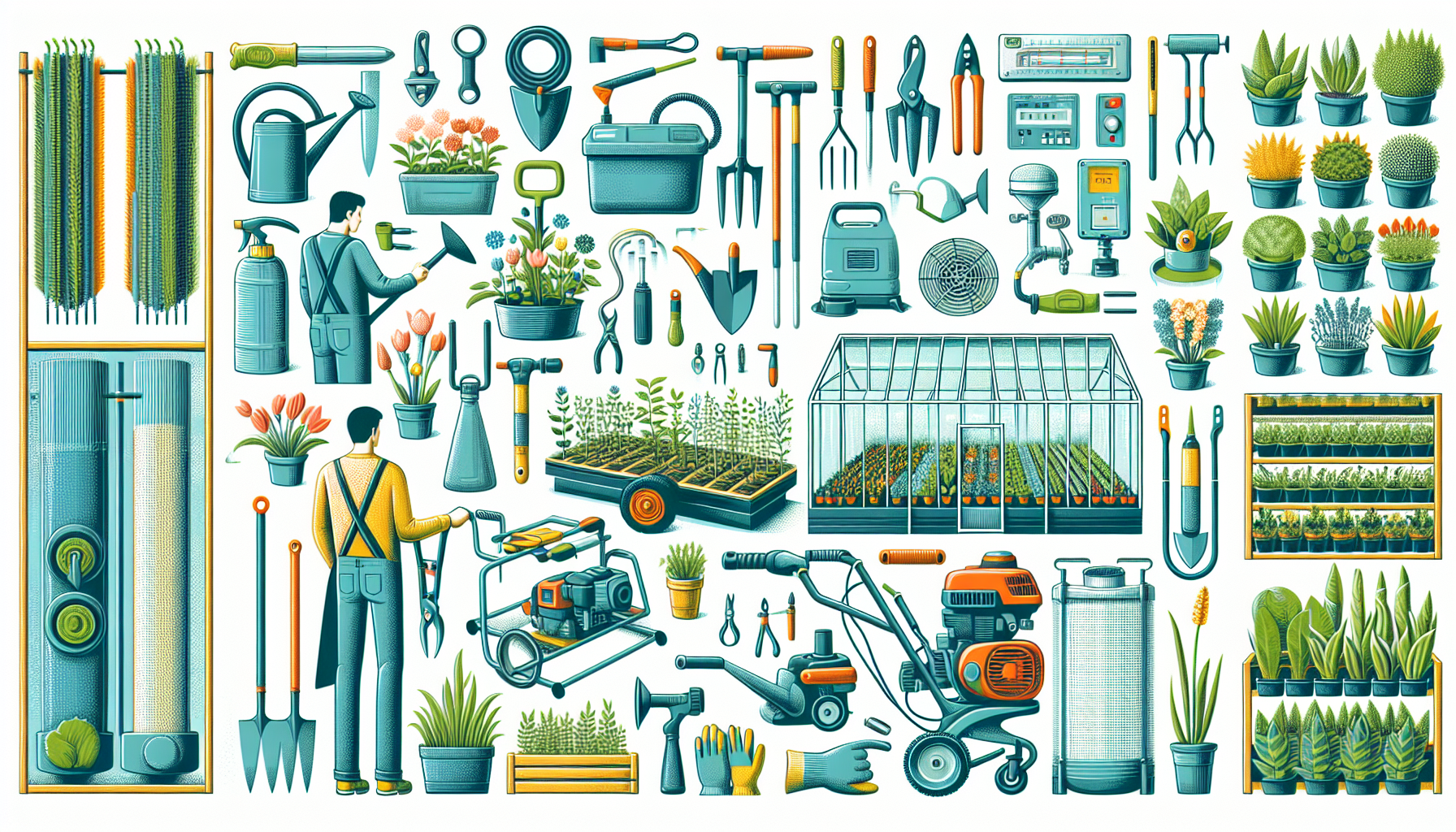
In the charming world of gardening, owning a greenhouse puts you in a unique league of enthusiasts who are not limited by weather conditions or seasons. To make the most of your precious greenhouse space, you’ll need to know your equipment essentials. “Essential Greenhouse Gardening Equipment Guide” lays out a clear path for you by detailing all the tools and equipment required for a successful and productive greenhouse. From must-have tools and temperature monitoring systems to irrigation essentials, the guide has got you covered. So, prepare yourself to elevate your gardening endeavors like never before!
Understanding the Greenhouse Structure
Setting up a greenhouse is more than just choosing the right seeds and soil; it’s about creating an environment that can sustain the life of your plants all year round. To do this, you need to understand the different types of structures involved in greenhouse gardening.
Types of Greenhouses
You’ll find various types of greenhouses available, so choose one that suits your gardening style, geographical location and climate. Some popular types include lean-tos, free-standing greenhouses, pit or sunken greenhouses, and dome-shaped ones.
Materials for Greenhouse Construction
The materials you select will affect your greenhouse’s effectiveness and longevity. Frames can be made of wood, steel, aluminum, or PVC, while coverings vary from glass, polyethylene, polycarbonate, or fiberglass. Take into account your climate, budget, and growing goals when deciding.
Insulation and Sealing
Insulation plays an integral role in maintaining a consistent temperature and preventing air leaks. You can insulate your greenhouse using bubble wrap, foam boards, or other insulative materials. Don’t forget materials for sealing gaps, such as weatherstripping and caulking, to prevent drafts and heat loss.
Glazing Options: Glass vs Polycarbonate
Glazing is crucial for controlling light and heat in the greenhouse. Glass is a traditional choice that provides excellent light transmission but needs regular cleaning and can be more expensive. On the other hand, polycarbonate is durable, less expensive, and provides good insulation, although it might not let in as much light.
Climate Control Systems
Managing the climate in your greenhouse takes more than open doors and windows. From thermostats to cooling systems, let’s explore the essential tools for effective climate control.
Thermostats and Temperature Regulation
Thermostats allow precision in maintaining the right temperature. Equip your greenhouse with a quality thermostat that can regulate the heating and cooling equipment based on your set parameters.
Humidity Control: Misters and Humidifiers
Maintaining the right humidity is vital for plant health. Misters and humidifiers can help increase humidity levels, essential for preventing plant diseases related to dry air.
Ventilation: Fans and Vents
Proper ventilation ensures your plants receive fresh air and promotes pollination. Fans circulate air, and vents provide fresh air intake and excess heat escape. Make sure you have a healthy balance of both.
Heating Solutions: Space Heaters and Heating Mats
During colder months, maintaining heat within your greenhouse is crucial. Space heaters are useful for heating the whole space, while heating mats are perfect for providing direct heat to your seedlings and plants.
Cooling Systems: Shade Cloths and Evaporative Coolers
Excessive heat can stress your plants. Shade cloths can filter direct sunlight, while evaporative coolers can drop temperatures via water evaporation. It’s important to choose a system that works for your specific climate and greenhouse setup.

Irrigation and Watering Tools
Hydration is the heart of every successful greenhouse. Let’s explore the range of watering tools available to keep your plants healthy and hydrated.
Watering Cans and Hose Attachments
For smaller greenhouses, watering cans and hose attachments are often enough to effectively hydrate your plants.
Drip Irrigation Systems
These systems are efficient for larger greenhouses, allowing water to drip slowly to the roots, limiting evaporation and water waste.
Automated Watering Systems
An automated system is a great tool for consistency when you’re not around. You can set it to water your plants at specific times, ensuring they always have the water they need.
Rainwater Collection and Storage
Collecting rainwater is an economical and sustainable way to water your garden, reducing reliance on municipal water. You’ll need storage tanks and a filtration system to make it work.
Soil and Compost Management
Good soil leads to great plants. Here are some tools to enhance your soil management practices.
Potting Benches and Soil Mixers
A potting bench is essential for preparing your plants, and a soil mixer ensures your soil ingredients are thoroughly combined for optimum plant health.
Compost Bins and Tumblers
Home-made compost is an excellent soil enhancer. Compost bins and tumblers expedite the composting process to make this nutrient-rich amendment.
Soil Testing Kits
Understanding your soil’s nutrient content and pH can guide you to make necessary adjustments for your plants to thrive.
Worm Farming for Soil Enrichment
Worm farming contributes to the creation of nutrient-rich compost while helping to reduce kitchen and garden waste.

Plant Support and Care
Caring for your plants goes beyond watering and ensuring they receive enough light. Here are some tools and methods for supporting your plants.
Stakes, Trellises, and Cages
These tools act as plant scaffolding, supporting your plants as they grow and assisting with air circulation to prevent disease.
Ties, Clips, and Plant Supports
Ties, clips, and plant supports are essential for directing plant growth and providing additional support to your plants.
Pruning Tools: Shears and Saws
These tools help you maintain plant size, enhance their shape, and remove diseased or dead parts to promote healthier growth.
Pest Control: Natural and Chemical Solutions
Insects and other pests can take a toll on your greenhouse plants. Natural and chemical solutions can keep these garden invaders in check.
Seed Starting and Propagation
Starting your plants from seed and cultivating new ones is a rewarding part of gardening. Here are some tools you’ll need.
Seed Trays and Germination Kits
These tools organize your seeds and provide an ideal environment for germination.
Heat Mats and Propagation Chambers
Heat mats and propagation chambers help to create the warm environment that seeds need to sprout.
Grow Lights and Bulbs
These provide the necessary light intensity and spectra for photosynthesis when natural light is lacking.
Rooting Hormones and Starter Fertilizers
These stimulate the root development and provide the necessary nutrients for young plants.
Monitoring and Measuring Devices
Data collection can help you maintain the right conditions in your greenhouse.
Thermometers and Hygrometers
These measure temperature and humidity levels, ensuring your plants are growing conditions are optimal.
Soil pH and Moisture Meters
Inform you on the acidity or alkalinity and water content of your soil, helping you make necessary adjustments.
Light Intensity Meters
Measure the amount of light your plants receive, helping you optimize your lighting arrangements.
CO2 Monitors and Regulators
These help maintain the right levels of carbon dioxide, which is vital for plant photosynthesis.
Gardening Accessories
Though not essential, these accessories can make your greenhouse management easier.
Gloves and Protective Gear
These are necessary for your safety while working with plants, soil, fertilizers, and other gardening materials.
Garden Carts and Wheelbarrows
These help transport heavy items around your greenhouse easily.
Tool Organizers and Storage Solutions
Proper organization and storage can make your gardening endeavors more efficient.
Cleaning Supplies and Disinfectants
Regular cleaning keeps your greenhouse tidy and prevents pests and diseases from spreading.
Energy Efficiency and Sustainability
Sustainable practices can not only help you reduce costs but also lessen your impact on the environment.
Solar Panels and Renewable Energy Options
Harnessing solar power to run your greenhouse can significantly reduce your energy consumption.
LED Lighting and Energy-Saving Bulbs
LED lights consume less energy and last longer than conventional bulbs, making them a worthy investment.
Insulating Materials and Energy Loss Prevention
Proper insulation can reduce energy wastage through heat loss.
Sustainable Water Use Practices
Using rainwater collection systems and water-saving irrigation practices can conserve water.
Greenhouse Maintenance and Upkeep
Maintaining your greenhouse ensures it continues to provide an optimum environment for plant growth.
Regular Cleaning Routines
Regular cleaning prevents the build-up of algae and mold and keeps pests at bay.
Inspection and Repair of Structural Components
Regular inspection helps to identify any wear and tear issues and address them before they become problematic.
Seasonal Adjustments and Equipment Calibration
Different seasons require varying levels of care. Regularly adjusting your equipment ensures optimum conditions year-round.
Pest and Disease Management Strategies
Preventive measures and regular monitoring can minimize pest and disease outbreaks in your greenhouse.
In the end, a well-structured and maintained greenhouse can make gardening more productive and enjoyable. Invest in suitable greenhouse gardening equipment to make the most of this gardening method. Remember, the key is to shape your greenhouse according to the specific needs of your plants and the local climate conditions.

